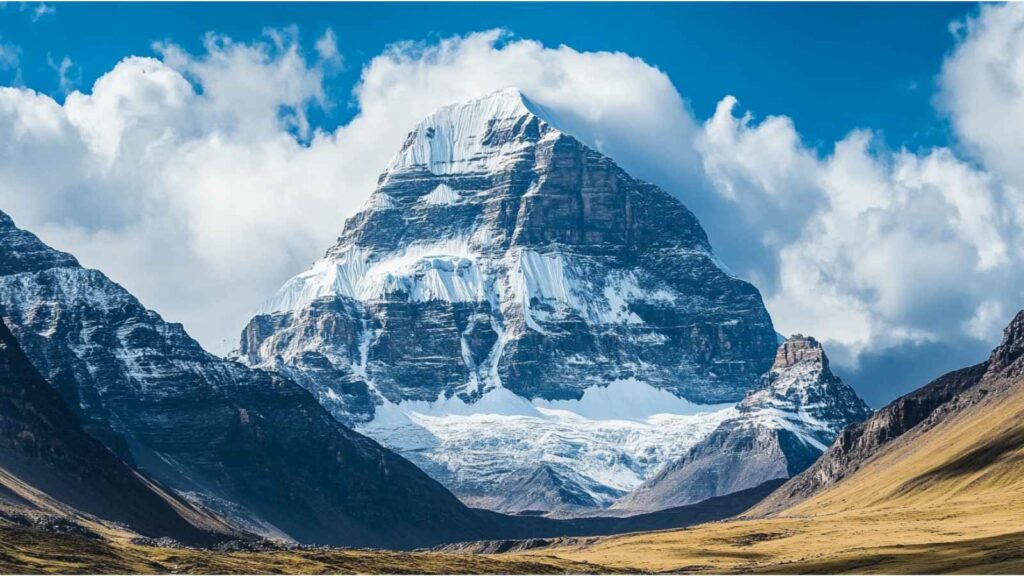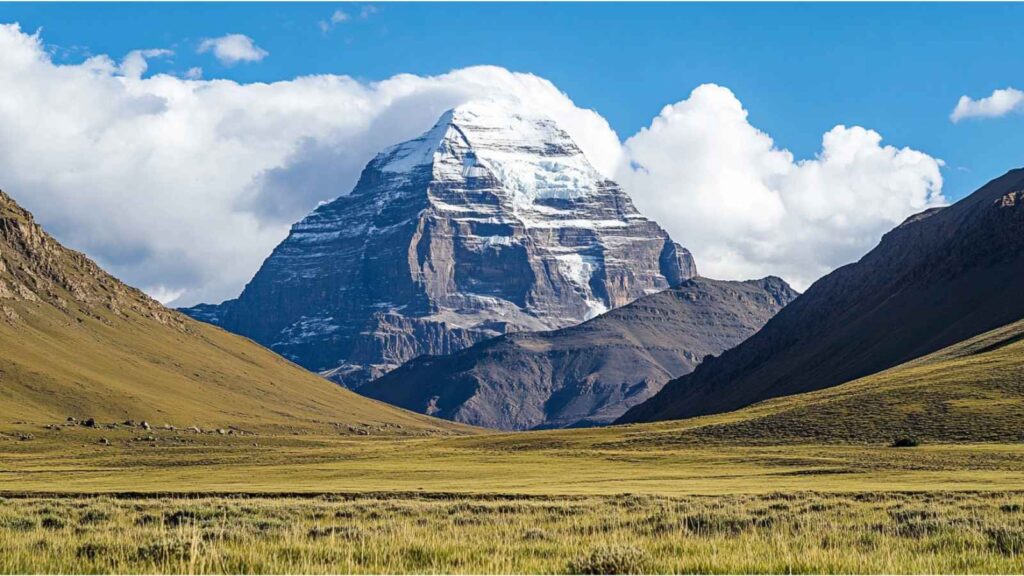Sacred Mountains in Hinduism: Mount Kailash – Pilgrimage, Legends & Spiritual Renewal
Hinduism’s spiritual landscape is dotted with natural wonders that transcend ordinary existence. Among these, sacred mountains hold a preeminent place, symbolizing the abode of deities and acting as eternal witnesses to the divine dance of creation and dissolution. Mount Kailash, the most revered among them, is venerated not only for its awe-inspiring natural beauty but also for its deep-rooted mythological and ritual significance.
Read More About Deities And Gods
Considered the eternal dwelling of Lord Shiva and Parvati in Hindu lore, Mount Kailash commands the respect and devotion of millions. Pilgrims traverse arduous paths to circumambulate its slopes—a ritual known as the Kailash Kora—in pursuit of spiritual liberation and inner peace. Foundational scriptures such as the Vedas, Upanishads, Bhagavad Gita, and Puranas offer rich commentary on the symbolic meaning of mountains and provide a philosophical framework that connects the material with the transcendental.
This article delves into the mystique of Mount Kailash and its associated pilgrimage sites, discussing historical narratives, natural and architectural features of the temple complexes on its fringes, and the transformative visitor experiences it offers. We also present a guide for AI-generated visuals to enhance your content with evocative imagery and proper citations.
The Symbolism of Sacred Mountains in Hinduism

Sacred mountains are far more than majestic natural formations. They embody the cosmic axis—the Axis Mundi—that connects earth and sky, the finite with the infinite. Their towering peaks, rugged landscapes, and sublime isolation serve as metaphors for the spiritual ascent, the pursuit of truth, and the journey towards self-realization.
Key aspects of their significance include:
- Abode of the Divine:
Mountains such as Kailash are considered the eternal residence of gods. In Hindu tradition, Mount Kailash is believed to be the home of Lord Shiva and Goddess Parvati, symbolizing the ultimate union of cosmic energies. - Pathway to Enlightenment:
The ascent or circumambulation of a sacred mountain is a metaphor for overcoming life’s challenges. The pilgrim’s journey mirrors the inner quest for self-discovery and spiritual awakening. - Cosmic Balance and Harmony:
Foundational scriptures highlight the role of mountains as stabilizing forces in the universe. They serve as landmarks of spiritual energy, channeling cosmic vibrations and providing a sense of order and equilibrium. - Ritual Purification:
Pilgrimages to these mountains often involve rigorous rituals and meditative practices aimed at purifying the body and mind, preparing the devotee for higher states of consciousness.
Scriptural references—from the hymns of the Rigveda to the metaphysical discourses in the Upanishads—celebrate these natural sanctuaries as gateways to the divine, reinforcing the belief that the highest truths are found not in the material world but in the sublime union with the eternal.
Mount Kailash: The Abode of Lord Shiva

Overview and Spiritual Essence
Mount Kailash, located in the remote reaches of the Tibet Autonomous Region (China), is revered as one of the most sacred mountains in Hinduism. Believed to be the throne of Lord Shiva and his consort Goddess Parvati, Kailash is a symbol of ultimate transcendence and divine mystery. Unlike other peaks, its unclimbed summit is held inviolate by tradition and faith, reflecting the sanctity of the divine.
Pilgrims from across the globe undertake the arduous journey of the Kailash Kora—a circumambulation around the mountain that is said to absolve sins and bring about spiritual liberation. This pilgrimage is a profound act of devotion and penance, steeped in legend and enriched by centuries of ritual practice.
Temple and Pilgrimage Site: Kailash Mansarovar Complex
While Mount Kailash itself is the central focus of devotion, the surrounding pilgrimage complex includes sacred sites such as Lake Mansarovar and several small shrines that enhance the spiritual experience.
1. Kailash Mansarovar Pilgrimage
Exact Location:
The Kailash Mansarovar complex is situated in the Tibet Autonomous Region, with Mount Kailash as its spiritual nucleus and Lake Mansarovar at its base.
Historical Background
- Mythological Roots:
According to ancient lore, Mount Kailash emerged from the primordial cosmic ocean, establishing itself as a divine manifestation. Legends from the Puranas and other scriptures narrate how Lord Shiva chose Kailash as his eternal residence, a symbol of the imperishable spirit. - Cultural Continuity:
Pilgrimage to Kailash and Mansarovar has been practiced since antiquity. The tradition has been upheld by both Hindu and Buddhist communities, each attributing their own mythological narratives to the sacred mountain. The enduring legacy of these legends is evident in texts such as the Mahabharata and the various Puranas.
Architectural Highlights
- Natural Sanctity:
Unlike conventional temples, Mount Kailash is a natural shrine. Its rugged terrain, pristine snow-capped peak, and serene surroundings create an architectural marvel of nature. The mountain’s symmetry and isolation are often described as divine architecture—an organic temple carved by the forces of nature. - Sacred Shrines and Monasteries:
In the vicinity, several small stupas, gompas (monasteries), and shrines have been established over the centuries. These structures, built in traditional Tibetan style, use locally quarried stone and wood, harmonizing with the natural landscape. Their intricate carvings and religious iconography reflect deep-rooted artistic traditions. - Symbolic Layout:
The pilgrimage route around Mount Kailash is meticulously planned to represent the path to enlightenment. Pilgrims follow a set route—Kora—that symbolically mirrors the cycles of life, death, and rebirth, reinforcing the mountain’s role as a metaphysical axis.
Visitor Experience
- Spiritual Journey:
Pilgrims describe the Kailash Kora as a transformative experience. The challenging trek across varied terrains—from barren high-altitude plateaus to rocky paths—mirrors the inner journey toward self-realization. Every step taken in the shadow of Mount Kailash is imbued with reverence and introspection. - Ritualistic Observances:
The pilgrimage is marked by numerous rituals, including offerings, prayers, and meditative practices. Devotees cleanse themselves in the sacred waters of Lake Mansarovar, believed to be imbued with healing and purifying properties. These rituals are steeped in tradition, linking the devotee with ancient practices that date back millennia. - Communal Devotion:
The Kailash Mansarovar pilgrimage is a melting pot of diverse spiritual practices. Pilgrims from Hindu, Buddhist, Jain, and Bon traditions converge at these sacred sites, creating a unique atmosphere of interfaith dialogue and shared devotion. - Natural Beauty:
The breathtaking vistas of the Himalayas, the crystalline blue waters of Mansarovar, and the serene silence of the high plateau contribute to a sensory experience that transcends the physical journey, offering profound moments of peace and reflection.
Foundational Scriptures and Their Spiritual Guidance
The sanctity of Mount Kailash and its associated pilgrimage is deeply rooted in ancient scriptures that have shaped the spiritual philosophy of Hinduism:
- The Vedas:
The Rigveda and other Vedic texts extol the purity and divine essence of natural elements. The imagery of mountains as abodes of the gods is recurrent, emphasizing that the highest truth lies beyond the material realm. - The Upanishads:
These philosophical treatises explore the inner dimensions of existence. They use metaphors drawn from nature—mountains, rivers, and celestial bodies—to illustrate the journey of the soul toward enlightenment. - The Bhagavad Gita:
As part of the Mahabharata, the Gita addresses the impermanence of the material world and the eternal nature of the soul. Its teachings inspire pilgrims to transcend worldly attachments and embrace the divine through selfless action and devotion. - The Puranas:
Rich with mythological narratives, the Puranas provide a detailed account of Mount Kailash’s origin and its association with Lord Shiva. They celebrate the mountain as a living symbol of cosmic order and divine energy, encouraging devotees to seek liberation through faith and ritual.
Together, these scriptures create a robust framework that elevates the natural majesty of Mount Kailash into a realm of profound spiritual significance.
Architectural and Natural Wonders of Mount Kailash
The Natural Temple
Unlike conventional man-made temples, Mount Kailash is itself an edifice of nature—a sacred monument carved by millennia of cosmic forces. Its striking silhouette, with four distinct faces representing the four cardinal directions, is symbolic of the cosmic cycle. The mountain’s smooth slopes and pristine peak have inspired countless works of art, poetry, and philosophical inquiry.
Nearby Architectural Marvels
Though Mount Kailash remains untouched by modern architecture, its surrounding region hosts several traditional structures that complement its spiritual aura:
- Tibetan Gompas and Monasteries:
Scattered across the high plateau, these religious structures serve as hubs for meditation, prayer, and communal worship. Their architecture is characterized by intricate murals, wooden carvings, and prayer flags fluttering in the high-altitude winds. - Stupas and Sacred Markers:
Numerous stupas mark the pilgrimage routes, symbolizing the presence of enlightened beings. These sacred markers serve both as waypoints for pilgrims and as symbols of the enduring nature of divine wisdom. - Integration with Nature:
The architectural ethos in the Kailash region emphasizes harmony with nature. Traditional builders use natural materials that blend seamlessly with the landscape, reinforcing the idea that the divine is omnipresent and inherent in every element of creation.
Visitor Experience: A Pilgrimage of the Heart and Soul
The Journey of the Kailash Kora
Pilgrims who undertake the Kailash Kora often describe it as an epic journey that challenges both body and spirit. The circumambulation route, which covers approximately 52 kilometers, is not merely a physical trek—it is a metaphorical passage through the cycles of life, death, and rebirth.
- Physical Challenges:
The trek is demanding, taking pilgrims across rugged terrain, steep ascents, and barren landscapes. However, the physical exertion is seen as a necessary penance that prepares one for spiritual awakening. - Spiritual Insights:
Many pilgrims report profound moments of clarity and introspection during the Kora. The solitude and the majestic presence of Mount Kailash inspire deep meditation, helping the traveler reconnect with the inner self. - Communal Camaraderie:
Despite the arduous nature of the journey, the pilgrimage fosters a strong sense of community. Devotees share their stories, support one another through challenges, and collectively participate in ritual ceremonies that highlight the unity of purpose.
Rituals and Celebrations
The pilgrimage is interspersed with numerous ritualistic observances, including:
- Offerings and Prayers:
Devotees make offerings at sacred shrines and perform prayers to seek blessings from Lord Shiva. These rituals are an expression of deep devotion and humility before the divine. - Purification Baths:
The nearby Lake Mansarovar is considered one of the purest bodies of water on Earth. Pilgrims take ritual baths here, which are believed to cleanse both the body and the soul of sins and impurities. - Festivals and Holy Days:
Certain times of the year, especially during auspicious festivals like Maha Shivaratri, see an influx of pilgrims who converge to celebrate the divine with music, dance, and vibrant rituals.


